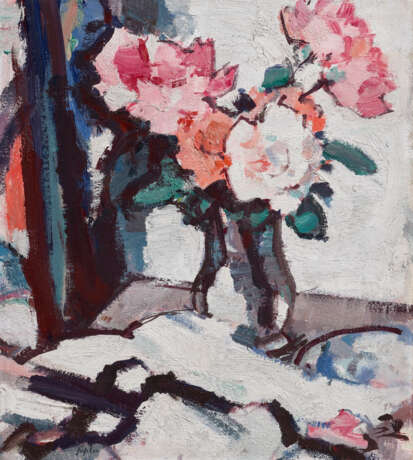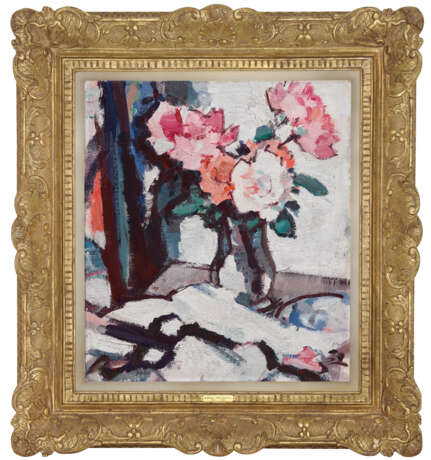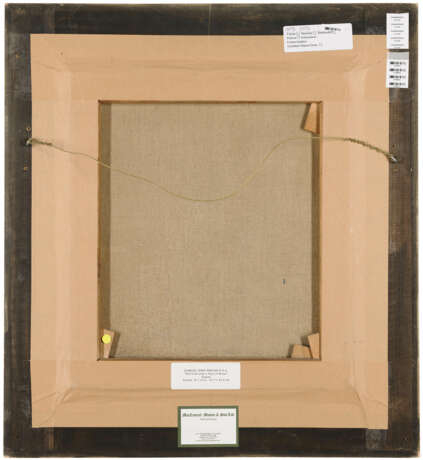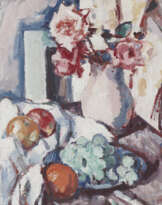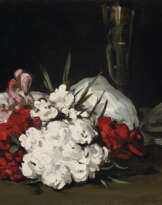ID 831320
Lot 231 | SAMUEL JOHN PEPLOE, R.S.A. (1871-1935)
Estimate value
£ 80 000 – 120 000
Pink Roses in a Glass Vase
signed 'Peploe' (lower left)
oil on canvas
18 x 16 in. (45.7 x 40.6 cm.)
Painted in the early 1920s.
Provenance
Anonymous sale; Sotheby's, Gleneagles, 29 August 1988, lot 1099.
Anonymous sale; Sotheby's, London, 1 September 1999, lot 1342.
with MacConnal-Mason, London, where purchased by the present owner in October 2000.
Post lot text
Pink Roses in a Glass Vase is a wonderful example of the vivid still-lifes that define S.J. Peploe’s work in the early 1920s. Throughout his career, Peploe seldom deviated from his aim to paint the perfect still-life, a fact he confirmed in a letter to another painter written in 1929: 'There is so much in mere objects, flowers, leaves, jugs, what not - colours, forms, relations - I can never see mystery coming to an end' (G. Peploe, S.J. Peploe, Farnham, 2012, pp. 112-113). Indeed, the limitless possibilities for variation of colour, form, and arrangement of the flowers, meant that this was a subject the artist repeatedly returned to as he rigorously explored compositional dynamics. Although he chose as his subject flowers that were available seasonally, the presence of roses across the development of Peploe’s oeuvre is particularly significant.
Widely considered as the height of the artist’s career, the early 1920s saw Peploe reach the vanguard of his modernist style. The present work, with its tonal planes of colour and expressive brushstrokes, is symptomatic of Post-Impressionism’s influence on the artist. Peploe’s rhythmic placement of the vase of roses juxtaposed by the supple forms of white drapery and angularity of the table-top creates a harmonious internal rhythm in the composition and is reminiscent of the flattening of pictorial space in the work of Paul Cézanne. Similarly, the application of a Fauvist palette in the petals’ delicate pink and fragrant orange, punctuated with slices of fuchsia and emerald green foliage, displays the influence of Henri Matisse.
Interestingly, white occupies each plane of the work, with a crisp white background, drapery, and central white rose offsetting the roses and drawing the work’s components together into a triumphantly composite whole. During this period, Peploe was particularly interested in the colour white, employing this visual device similarly in another painting, Still-life, White Roses, in the collection of the Kelvingrove Gallery, Glasgow. However, despite these avant-garde influences, Peploe’s hand remains distinctly idiosyncratic, perpetuating the sentiments of a critic in 1914: ‘he gets the best out of them, gaining from them what licence for freedom of line and abandonment of colour he may require, but preserving always evidence of contact with life’ (‘Studio-talk,’ The Studio, vol. 61, 1914, p. 232).
| Artist: | Samuel John Peploe (1871 - 1935) |
|---|---|
| Applied technique: | Oil on canvas |
| Art style: | Modern art |
| Genre: | Still life |
| Auction house category: | Paintings |
| Artist: | Samuel John Peploe (1871 - 1935) |
|---|---|
| Applied technique: | Oil on canvas |
| Art style: | Modern art |
| Genre: | Still life |
| Auction house category: | Paintings |
| Address of auction |
CHRISTIE'S 8 King Street, St. James's SW1Y 6QT London United Kingdom | |
|---|---|---|
| Preview |
| |
| Phone | +44 (0)20 7839 9060 | |
| Buyer Premium | see on Website | |
| Conditions of purchase | Conditions of purchase |
